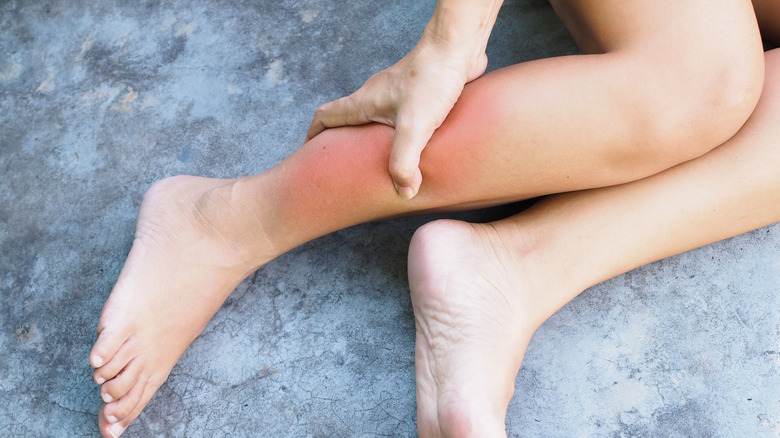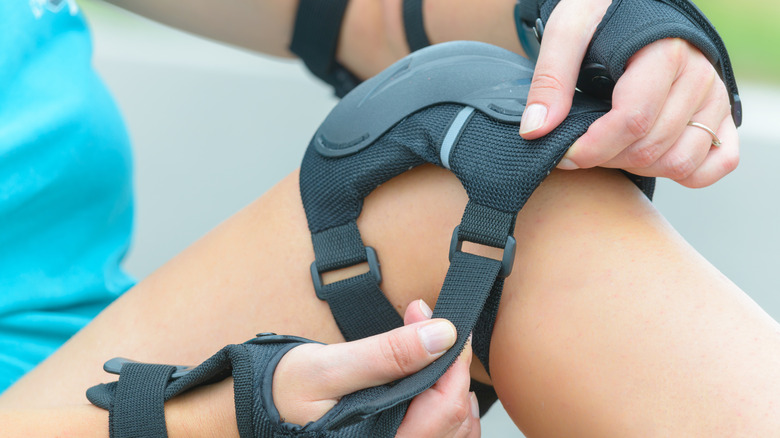This Is When To Get Worried About Cellulitis
For some illnesses, it's easy to take the wait-and-see approach. For example, when you bruise your knee falling down the stairs, you can wait to see if rest, elevation, and rest clear it up rather than going to the doctor. However, cellulitis is a condition you don't want to ignore or wait and see if it improves. Acting early rather than later can save you complications.
According to the Centers for Disease Control and Prevention (CDC), cellulitis is a skin infection that leads to pain and swelling. The most common cause of cellulitis is when bacteria, mainly Streptococcus and Staphylococcus, work their way through the skin's protective barrier into the deeper layers, like through an open wound. It has many common symptoms — like fever, swelling, and rash — that should have you running rather than walking to your doctor's office to get some antibiotics. This is especially true for those with a weakened immune system and chronic health conditions like diabetes.
Be vigilant about your health by learning when to start worrying about cellulitis.
Cellulitis symptoms to worry about
Not every cut or scrape you get on your skin will lead to cellulitis. However, you don't want to ignore symptoms of infection from that patch of eczema or cut from falling in the yard. The American Academy of Dermatology (AAD) states that redness, swelling, and warmth can be some of the first symptoms of cellulitis. "The problem is a lot of things present the same bread-and-butter symptoms – redness, warmth, swelling. So cellulitis can be tough to diagnose," according to Jake Mefford, clinical director of OSF OnCall Urgent Care at OSF Healthcare.
However, without antibiotics to target those bacteria, they can easily get out of control and spread, allowing them to move into deeper layers of the skin and bloodstream. So, the early symptoms will elevate with the spreading infection to fever, cold sweats, chills, increasing pain, and red lines from the wound. You might even experience blackening skin and abscesses, any of which require immediate medical attention for cellulitis (per Healthline). If left unchecked, the CDC notes that complications like a blood infection or bone infection could happen. That's why you'll want to act fast if you even think cellulitis is causing the increasing pain and redness on your new tattoo.
You can't always prevent cellulitis from happening, but there are steps you can take to lessen the likelihood of it affecting your life. To keep your worry at bay, we have the top tips to help prevent cellulitis from happening in the first place.
How to prevent cellulitis
Cellulitis isn't just a bummer now; it's a bummer later as well. Once you've succumbed to the grip of cellulitis in your life, the chances of getting it again are higher. As Mefford stated in OSF Healthcare, "Our bodies are covered with good and bad bacteria, no matter what we do. It's not hard to get an infection." So, it's vital to mitigate the infection possibility by avoiding wounds in the first place.
Since bacteria need a break in the skin to begin causing mayhem, make sure to keep your skin moist by applying moisturizer regularly. You'll also want to avoid anything that might cause harm to the skin by wearing properly fitting shoes and clothing, keeping your nails trimmed, and wearing protective equipment when biking or playing sports. When breaks in the skin happen, clean wounds with soap and water before applying antibacterial ointment and a bandage. Also, make sure to change out the bandage regularly to stay on top of those germs. The AAD also recommends losing weight, quitting smoking, and treating conditions that give you a higher risk for cellulitis, like eczema and diabetes.
Cellulitis isn't a condition that you want to mess with. So, make sure to monitor any breaks in the skin for increased redness, swelling, or other signs of infection. If in doubt, don't wait. Make an appointment with a healthcare provider immediately to get it checked out.



